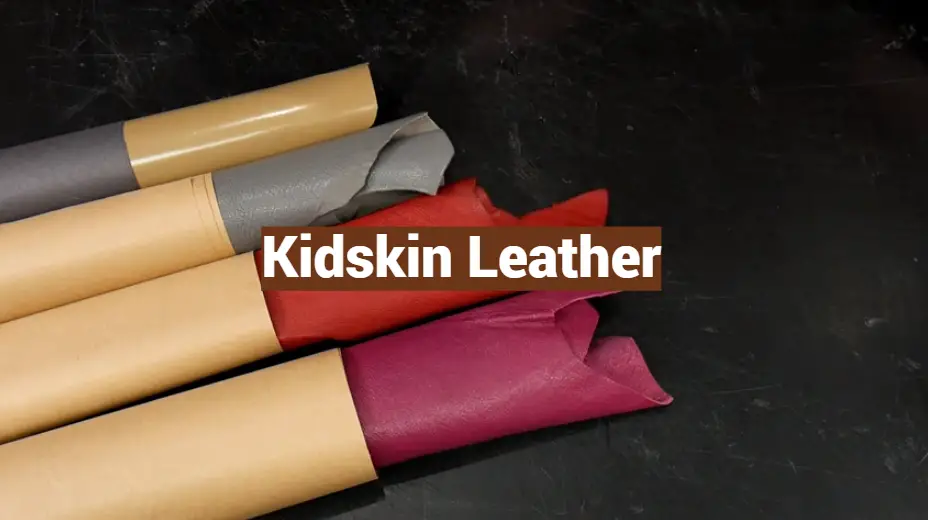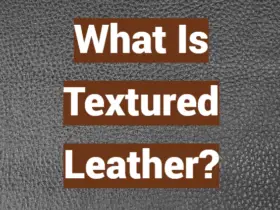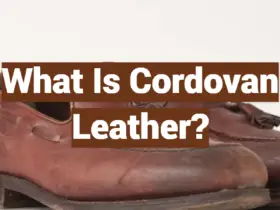If you’re a leather fan, then you’re very likely to define kidskin leather. Don’t panic if you don’t know what it is since this material has many titles. Kidskin is a hide or skin originating from a goat. So basically it is goatskin but the hides of a baby goat are used during the processing. Just like goatskin, kidskin leather is often referred to as Morocco leather. It is recognized for its smooth texture and lightweight. It is also one of the most resistant and waterproof leathers on the market.
Definition
Kidskin is often ultra-thin to the touch and has a very velvety finish. The semi-aniline finish is the most popular version of kidskin’s tanned material. This material is usually colored with aniline dyes and then a covered lacquer layer is added with a combination of leather paints. In such a way kidskin gets an even and glossy finish.
Preparing the hides for tanning is the first step in producing kidskin. Preparation involves maintaining the dry hide, extracting excess protein, hair, and fat, and adding chemicals and salts to the hide to help in the absorption of tanning products. The leather is tanned and dried until this phase is finished. Tanning also better protects the hide and prevents it from rotting. Current tanning procedures require tannins, chromium sulfate, or aluminum salts.
Kidskin is ultra-thin much like paper varying from 0.02 to 1.10 mm thick. Kidskin is a type of natural leather developed from goat hides. Kidskin is mostly made from the hides of baby goats, as the name suggests, but it can also be made from the pelts of fully-grown goats.
A lightweight, supple and premium finish is how you may describe kidskin leather. While it can be turned into almost any form of leather footwear or accessory, it is most commonly used for making ballet shoes for women. Though, its uses are much wider.
Major Types of Kidskin Leather
Since 1916 merchants and leather craftsmen have defined and distinguished 60 different types of kidskin leather. The most popular materials are:
- Bronze kidskin (dyed for a nice bronze finish);
- Cheveril (more flexible than standard kidskin);
- Dongola (resembles kidskin but can include the hides of sheep or kangaroo);
- Glace (or glazed) kidskin has an extremely glossy, shiny finish;
- French kidskin – top-notch material in the terms of quality;
- Kangaroo kidskin is a goatskin finished to mimic kangaroo leather’s texture;
- Mat kidskin is beeswax and olive-oil treated material with a dull, soft matte finish.
- Pebbled kidskin;
- Royal kidskin;
- Suede kidskin has a nice suede finish;
- Vici kidskin is a trademark for high-quality chrome-tanned kidskin with a soapy and oily finish, developed by Robert Foederer in Philadelphia in the mid-1880s;
Kidskin vs. Calfskin
You should never confuse kidskin leather with calfskin or cowhide. The key distinction between kidskin and calfskin is that kidskin is a smoother, thinner leather made of goatskin, typically used for gloves. While calfskin is a natural leather created from a calf’s hide.
A lot of leather materials originate from cowhides, although there are also other leather origins. Kidskin and calfskin are usually of better quality and appear to cost more than pigskin or side leather. Calfskin leather, owing to its great shine, depth of color, and ability to avoid scuffing, is typically the most costly variety of leather. Kidskin leather is thinner, heavier and thus more durable than calfskin, offering a broad range of choices for style.
Kidskins can come in several varieties of finishes – including veg tanning, aniline, semi-aniline and crust. Calfskin doesn’t have such a number of finishes.
Kidskin is considered as a higher-quality material, like calfskin, and this is typically expressed in the cost of the leather goods. It is also used for a variety of leather pieces because this leather type appears to be a little lighter in weight than calfskin although being a very solid fiber. This makes kidskin leather very durable and can be used to create virtually every type of accessory. It is most widely used, however, to produce leather gloves, ballet shoes and different iPhone/iPad covers.
Uses
Kidskin is used by the manufacturers and makers of gloves. Some craftsmen and brands also create very thin and durable slippers with this premium leather material.
Used primarily for gloves, it is very durable and very luxurious since it is ultra-soft and extremely lightweight. Often, early lightweight hair rollers were made of kidskin, offering a curl that was really tight. In the doll-making industry, especially during the nineteenth and early twentieth centuries, kidskin was particularly widely used as a common material for both French and German doll bodies, especially fashion dolls.
Also, kidskin is used for the creation of musical instruments, such as Greek bagpipes. It was also a choice for drumheads such as those on tambourines and, in particular, on dairies from Bulgaria. Backs in the days, it was used in lighthouses, the Dalen light was made with a saturated paraffin-wax kidskin diaphragm.
Benefits
- Soft;
- Lightweight;
- Water-resistant;
- Supple;
- Flexible;
Thanks to such premium features as adaptability, versatility and suppleness, kidskin leather is often used for making soft and durable accessories. This leather is often strikingly lightweight. It very much resembles calfskin if you need to compare its features with other natural leather materials. Kidskin leather is also known for its exceptional quality, and the cost of such leather products typically represents this.
Kidskin often happens to be more lightweight than calfskin although being a very solid fiber, mostly used for a range of leather pieces. This makes it easy to render the leather very durable and can be used to manufacture virtually any leather clothes or accessories.
Care and Maintenance
To ensure the lifespan of top-notch and ultra-thin kidskin leather gloves or accessories, you should be very careful when cleaning and maintaining the material’s condition. Kidskin should be put and processed at mild temperatures, like other forms of leather. To prevent regions of excessive dryness or humidity you should repeat these precautions all the time. Following this routine would enable the leather to preserve its natural appearance and texture over time. Also, you may reduce the chance of cracks appearing on kidskin’s texture.
You should brush off kidskin leather if appropriate with a smooth, dry cloth in order to maintain and clean this material. It is then necessary to very carefully clean the product with lukewarm water.
Furthermore, a special leather cream, saddle soap and conditioner may be used. Apply these treatments after you have cleaned the kidskin leather. Then leave it to dry naturally without covering.
Proper maintenance and cleaning of kidskin clothes and accessories will help to minimize cracks and possible shrinking, thus increasing the lifetime of the garment.
FAQ
What are the benefits of using kidskin leather?
One of the benefits of using kidskin leather is that it is very soft and supple. This makes it a desirable choice for items that need to be comfortable, such as gloves, shoes, and clothing.
Kidskin is also less likely to cause skin irritations or allergic reactions, making it a good option for those with sensitive skin. Additionally, kidskin is a durable material that can withstand wear and tear well.
Are there any downsides to using kidskin leather?
There is always the possibility of allergies when it comes to kidskin leather. Kidskin is a type of soft, thin leather that is made from the skin of young goats. It’s very soft and pliable, making it a popular choice for gloves, shoes, and other accessories.
However, kidskin is made from the skin of young animals. There is always a chance that someone could have an allergic reaction to it. If you are thinking of purchasing items made from kidskin leather, it is important to test a small area of your skin first. Some people might be allergic to leather, so it is important to test it first.
Are there any special precautions that should be taken when caring for kidskin leather goods?
There are a few things to keep in mind when caring for kidskin:
- Kidskin is more delicate than adult skin, so it needs gentle care. When cleaning and moisturising kidskin, use a mild soap and avoid scrubbing or using harsh chemicals.
- Kidskin is more sensitive to the sun than adult skin, so it is important to apply sunscreen regularly, especially if your child will be spending time outside.
- As kidskin matures, you may need to change the way you take care of it. For example, you may need to start using a stronger soap or apply sunscreen more often.
What industries commonly use kidskin leather?
Industries that commonly use kidskin leather include the fashion industry, the motorcycle industry, and the furniture industry.
Kidskin is a popular choice for clothing and accessories because it is soft and smooth. It is also strong and resilient, which makes it a good choice for furniture and motorcycle gear.
Is kidskin leather good?
Kidskin leather is a type of soft, delicate leather that is made from the skin of a young lamb or goat. The leather is tanned using a vegetable-based process, which makes it less likely to cause an allergic reaction in people who are sensitive to other types of animal-based leather. This also makes the leather more environmentally friendly.
Kidskin leather is often used to make gloves, shoes, and other items that need a delicate and soft material. People think that kidskin leather is one of the best types of leather because it is so gentle on the skin.
How is kidskin made?
Kidskin is made from the skin of young animals. The skin is removed while the animal is still alive, and then it is treated to give it its characteristic soft texture.
Kidskin tanning is an old process that takes a lot of skill. The tanner needs to use the right amount of water and heat to keep the leather flexible. If they don’t, it might crack or peel.
The finished product is soft and supple, making it perfect for gloves, shoes, and other accessories. It is also very durable, making it a popular choice for upholstery and other furniture applications.
How do I know if a product is made of kidskin leather?
There is no one definitive answer to this question, as it depends on the manufacturer and the specific product in question. One common indicator that a product may be made of kidskin leather is if it is marketed as being “soft” or “luxurious”. Additionally, products made of kidskin leather are often more expensive than those made of other types of leather.
If you’re not sure whether a particular product is made of kidskin leather, you can always contact the manufacturer to ask.
Which is better, kidskin or crossgrain leather?
Kidskin is better. Kidskin is a type of leather that is made from the skin of young animals. It is soft, pliable, and has a fine grain. Crossgrain leather is made from the hide of an animal that has been split into two pieces. The top layer and the bottom layer are each divided into narrow strips called flitches. These strips are then crosscut in a crisscross pattern, which gives the leather its name. Crossgrain leather is more durable than kidskin, but it is not as soft or smooth.
Which is better, kidskin or faux leather?
There is no clear answer, as it depends on your preferences and needs. Kidskin is a natural material made from the skin of young animals. Faux leather is a synthetic material made from various chemicals and plastics.
There are two types of leather: kidskin and faux leather. Kidskin is more expensive but it is considered to be of better quality. It is also softer and more flexible than faux leather, which can make it more comfortable to wear. Faux leather, on the other hand, is cheaper and can be more resilient to wear and tear. It is also easier to clean and less prone to staining than kidskin.
Which is better, kidskin or full-grain leather?
There are pros and cons to both types of leather. Kidskin is finer and softer than full-grain leather, making it more comfortable to wear. However, kidskin is also less durable than full-grain leather and may show signs of wear and tear over time.
Full-grain leather is stronger and more durable than kidskin. It is a better option for products that need to withstand heavy use. However, full-grain leather can be quite stiff and inflexible, which some people may find uncomfortable to wear.
Related Video: All About Kidskin – And Why You’ll Love It!
Final thoughts
Kidskin is goat-based leather material. As you can possibly imagine, this kind of leather usually comes from the hides of baby goats. You may want to choose this material to make soft, lightweight and sturdy gloves or tablet covers.







I was recently given the opportunity to review a product that I had never heard of before – kidskin leather. Kidskin is a type of leather that is made from the skin of a young goat or lamb. It is said to be softer and more delicate than other types of leather, making it a popular choice for upholstery, clothing, and other accessories.
I was really excited to try out this new material, so I decided to test it out by making a small project – a waterproof pouch for my phone. I cut a piece of kidskin leather to size and sewed the edges together using a simple straight stitch. I then tested the pouch by submerging it in water for half an hour. To my surprise, the leather remained completely dry!
I was really happy with how well the kidskin leather held up, and I can’t wait to use it in future projects. I would definitely recommend this material to anyone who is looking for a durable and waterproof alternative to traditional fabrics.